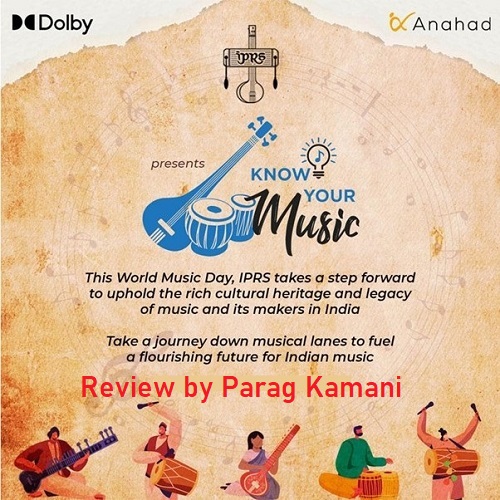IPRS and Dolby join hands to spotlight folk music


Atul Churamani
Any panel or webinar that features the presence of music industry veteran Atul Churamani, who is also the managing director of Turnkey Music and Publishing, ensures that there exists – among other virtues – focus, transparency, learnings, and discovery. And, so it was, when the Indian Performing Right Society (IPRS), in conjunction with Dolby Laboratories, launched their #KNOWYOURMUSIC campaign on 21.06.21 to celebrate World Music Day.
Among the other participants, Abhinav Agarwal [founder-director of Anahad Foundation], Hemjit Maloo [director at Veena Music] and Mayur Puri [as the host] were also present, but the obvious attention remained on, besides Churamani, Kashmiri folk singer and former Indian Idol finalist Aabha Hanjura, and music composer Shantanu Moitra.

Shantanu Moitra
While the focus of the session was folk music, Moitra spoke about the relevance of the genre by comparing it with a raw or uncut diamonds, saying that for the music to travel to a broader audience, changes were essential in the traditional music form to make folk more accessible. Moitra cited several reasons for doing so: one, the lyrics are repetitive; two, the downside of hearing music with minimalistic sound, due to its unsophisticated instrumentation on a superior sound system, creates disappointment for listeners; and, last, the difficulty of understanding the lyrics itself, which are usually in a language or dialect that the listener is not familiar with [effectively, Moitra, reiterated the point initially raised by Churamani].
Moitra dwelled into his treasure trove of memories as he spoke about interacting with a folk singer who, he believed, was unaware of life beyond her simplistic life in a small town, until she showed him a photograph of her sandwiched between two persons, whose faces that appeared familiar to Moitra, but he remained unsure about them until he turned over the photograph and read about their identities: John McLaughlin and Eric Clapton! More nostalgia flowed as Churamani and Moitra also reminisced the release of ‘Mann Ke Manjeere’ – the album and music video supported by a campaign created by human rights organization ‘Breakthrough’ which promoted women’s rights – back in 2020, if this writer remembers correctly, as he was part of the record label, Virgin Records [also known as EMI India; since merged with Universal Music], that released it then.
Moitra was clearly emphatic about making the genre’s future brighter by mentioning that “Rajasthani is not the only folk music” that exists in India and, at the same time, proposing that the government steps into formulating a policy promoting the genre by having radio stations allocate at least one hour a day dedicated to folk music.
From Kashmir arrived Aabha Hanjura, who has taken the mantle of promoting the sounds of her state to a wider audience through her singing talent over the past ten years or so. Supporting Kashmiri rhythms

Aabha Hanjura
– notably, with the usage of rabab and the darbukka – combined with modern dance beats courtesy Western instrumentation, indicates how effectively musicians integrate different traditions into modern pop. In fact, in a review written six years ago, this writer said: “The central point in all this remains the alluring singing from singer-songwriter Aabha”. Nothing has changed, really, as Hanjura provided a demo of her immense talent by singing an impromptu, acapella rendition of her extremely popular “Hukus Bukus”. Her inputs, too, made it clear about the brilliant future of the genre stating that “folk lives forever…on and on…”

Nanni Singh
The Anahad Foundation entered the association as an NGO that works towards the recognition, preservation, and evolution of Indian folk music, joining hands with IPRS to reach out to that segment of folk music creators who have largely remained unrecognised. In supporting the initiative, IPRS is apparently enrolling over 100 folk artists as members. Additionally, Dolby is on board to help reinvent how best songs can be musically experienced which, said Agarwal, was already available through Hungama Digital Media Entertainment, and would soon follow on Apple Music.
Atul Churamani, in leveraging his long-standing and successful stint in the long forgotten abbreviation A&R – as in Artist & Repertoire – spoke about his experiences in initiating the ‘Paddy Fields’ annual festival, and curating and directing Nanni Singh’s ShowCase Events’ ‘Sounds From The Desert’, a concert that arrived at Mumbai’s Royal Opera House on 25.09.19, and was repeated in New Delhi. Churamani also spoke about the genesis of folk music being women, essentially mothers telling tales to their children, and spoke about the necessity of instigating curiosity as a factor to take the folk genre to a wider audience.

Narendra Kusnur

Merlin Dsouza
Also as part of the World Music Day celebrations, Music Plus presented ‘The Music Huddle’ across three days featuring, among other programmes, reputed journalist Narendra Kusnur speaking to “handpicked” independent artists about their music, but the true precursor of the annual celebratory day went to keyboardist Merlin “magic fingers” D’Souza as she presented, on 20.06.21, ‘The Piano Diaries’ with singer Hamsika Iyer, along with a guest appearance by Merlin’s son, Rhys Sebastian, on saxophone, running through her hits and popular songs.
While World Music Day 2021 has no doubt been revelling, one does look forward to moving out from virtual reality into the physical space once the pandemic is through just as music should move out from merely being a heard mentality, to an experiential one…









